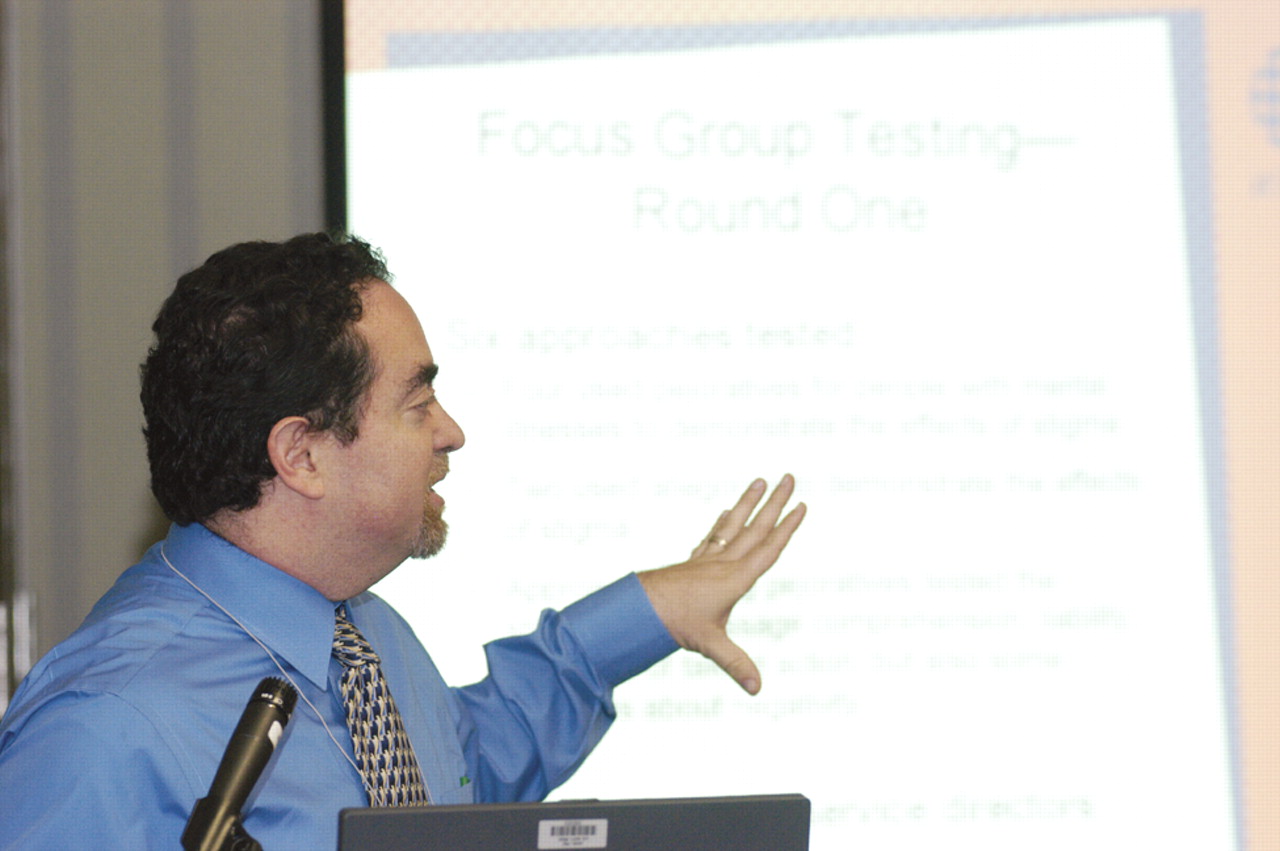The Substance Abuse and Mental Health Services Administration (SAMHSA) has begun a series of ambitious and sophisticated efforts to combat stigma and discrimination toward those with mental illness.
Paolo Del Vecchio, SAMHSA's associate director for consumer affairs, and Christopher Marshall, consumer affairs specialist, reminded attendees at APA's 2005 Institute on Psychiatric Services that the New Freedom Commission on Mental Health called stigma the “most pervasive barrier to mental health” and recommended a “national campaign to reduce the stigma of seeking care” in its final report in July 2003.
In September of that year, SAMHSA launched the Elimination of Barriers Initiative (EBI) to identify effective public education approaches to that problem. Eight states—California, Florida, Massachusetts, North Carolina, Ohio, Pennsylvania, Texas, and Wisconsin—have piloted different methods of changing perceptions that result in stigma.
“We can't do the job with just one strategy,” said Del Vecchio. States also selected from among target audiences that included the educational and business communities, as well as members of the general public.
Help to the state projects has been available from the EBI team, which includes communications, mental health, and evaluation experts. Upon completion of evaluations at the end of the three-year project, SAMHSA will distribute promising practices that can be adopted by individual states.
The American Psychiatric Foundation was a partner in the Voice Awards, another activity sponsored through the EBI. In July the writers and producers of the movie “The Aviator” and the television shows“ ER,” “Monk,” and “Scrubs” received Voice Awards for their positive portrayals of people with mental health problems (Psychiatric News, September 16).
Neal Baer, executive producer of “Law and Order: SVU” and former executive producer of “ER,” received a special award for bringing mental health issues into the mainstream. He co-created the character of Maggie Lockhart (played by Sally Field), a woman who ultimately recovered from bipolar disorder on “ER.”
Marshall spoke about SAMHSA's National Anti-Stigma Campaign (NASC), a three-year public service campaign that involves efforts to identify the sources of stigma and messages that would help bring about changes in attitudes.
Surveys conducted beginning in the 1950s revealed that members of the general public had a fear of “unpredictable violence” from those with mental illness and showed little understanding of its scientific basis, said Marshall. They had problems distinguishing between mental illness and“ worry.”
In 1996, according to the MacArthur Mental Health Module of the General Social Survey, respondents reported a greater scientific understanding of mental illness. However, nearly twice as many people reported a belief that violence is associated with mental illness.
To explore current perceptions about mental illness, NASC conducted 20 in-depth interviews of a racially diverse mix of men and women aged 25 to 75 from April 5 to 7. All respondents were screened to exclude those who had personally experienced a mental illness or who had close friends or family members with a mental illness. The results have not been published.
The media was the principal source of information about mental illness for the interviewees. Negative examples are sensationalized news stories about shootings in schools and women who killed their children. Respondents learned about positive stories of recovery from television shows like the “Oprah Winfrey Show.”
Researchers hypothesized that knowledge of the prevalence of mental illness would help to “normalize” it. They told the interviewees that in 2003 an estimated 28 million adults received treatment for mental health problems. This number represents 1 in 7 of the adult population.
The majority of the interviewees, however, were “unimpressed” by these figures. Those respondents who were impressed were those who knew the least about mental illness and would require the greatest amount of work to educate.
Other findings from the interviews suggest more hopeful outcomes from educational efforts about mental illness. Knowledge about and experience with depression have helped to normalize it. Respondents expressed the most hesitancy and fear about schizophrenia and had the least amount of knowledge and experience with it.
Interviews also revealed feelings of compassion from the respondents and confusion about how to relate to people with mental illness. “I feel sorry for them, but I can't relate to them,” said one respondent.
Interviewees were particularly concerned about triggering an episode of violence by saying the wrong thing or responding in a provocative manner to a mentally ill person.
“People don't think about mental illness or how they respond to people with mental illness,” Marshall said, “unless put in a situation in which they are forced to confront their beliefs and behaviors. When confronted, they are ashamed of the way they behave.”
What might change attitudes?
The most promising finding from the interviews is consistent with a key theme of the report of the New Freedom Commission on Mental Health. That report called for a transformation of the mental health system to promote the recovery of every person with mental illness.
Interviewers found that fears expressed by the respondents about mental illness and their own inability to relate to people with it could be countered by data concerning the likelihood of recovery.
“They responded with shock to recovery statistics,” said Marshall. Interviewers cited data from the National Institute of Mental Health that indicated that the majority of individuals with mental illnesses do recover and lead full and meaningful lives in their communities.
Public education messages should focus on the idea that people can recover and lead productive and meaningful lives, according to the researchers.
The eight EBI state demonstrations developed and distributed newspaper, radio, and television advertisements emphasizing these themes. The text for one newspaper ad reads, “Every day, someone with a mental health problem: pops the question, earns a promotion, makes the grade. Mental health problems are so common that they affect almost every family in America. Yet most people who have mental health problems recover from them....”
The NASC will build on these themes and counter negative assumptions about individuals with mental illnesses. The campaign will also use the promising message of recovery to encourage individuals with mental health problems to seek help.SAMHSA is working with the Advertising Council Inc. to develop and distrib
Information about SAMHSA's campaigns against stigma and discrimination is posted at<www.allmentalhealth.samhsa.gov> and<www.stopstigma.samhsa.gov>.▪

